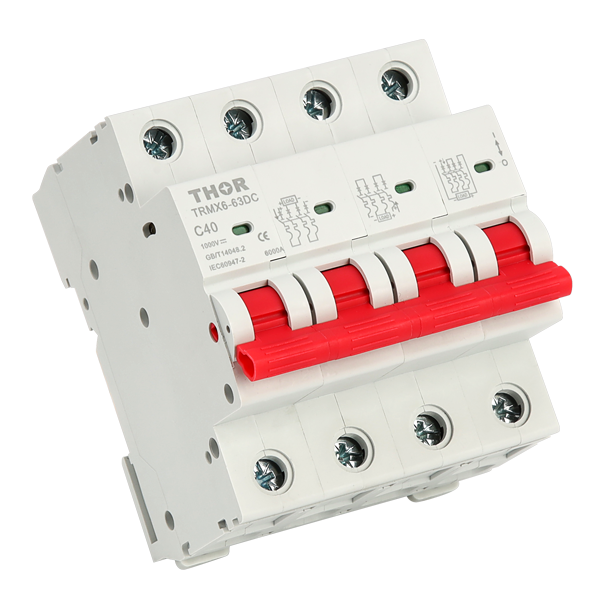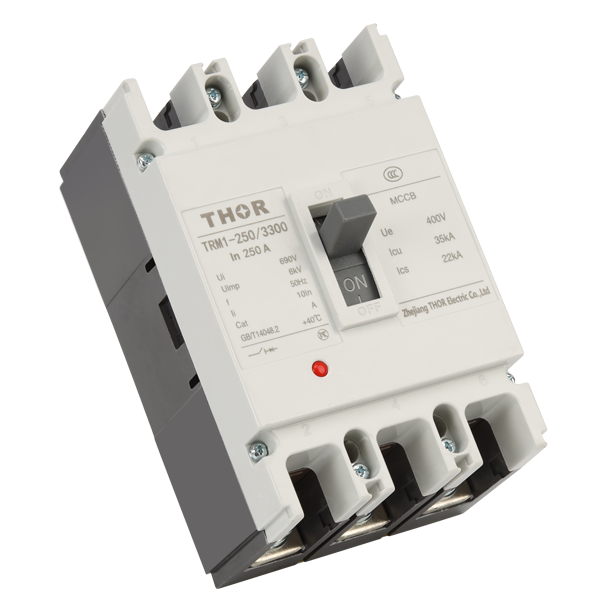Using an AC MCCB in place of a DC MCCB is not recommended due to differences in voltage handling and arc interruption capabilities.
Introduction
Molded Case Circuit Breakers (MCCBs) are vital for protection of electrical circuits against abnormal conditions such as over current which can damage equipment and pose a risk to safety personnel. This installment will examine the differences in duties for AC and DC MCCBs, as well as sort out whether they can be swapped back and forth.
AC MCCB is meant to interrupt the power flow in an AC circuit, where the current periodically changes direction. This cyclical nature allows ac mccbs to interrupt the current flow more easily at zero current moments. Whereas DC MCCBs, on the other hand, are specifically designed for circuits where current flows only in one direction all the time; therein lies the problem - It is more difficult to interrupt such a flow of current as there are no natural zero points.
Technical Considerations
This interruption capacity of AC MCCBs is less than their DC counterparts as DC has a different arc extinction nature. An AC MCCB rated for 415 Volts may be [in]effective as low as 250 Volts when fitted in a DC system, because DC arcs are more vigorous and difficult to quench.
Safety Implications
The safety of using an AC MCCB in a DC system is also compromised greatly. Proper interruption of current cannot happen with a given setting of an AC MCCB which can result in continuous arcing. The heating produced by these arcs can overheat the circuitry and ultimately cause fires.
Functional Limitations
As an aside, AC MCCBs should not be used in DC systems because they are not rated for the continuous current flow that is inherent in DC. ConclusionThe mismatch between the breaker and the battery can lead to starvation of the bus bar, a scenario that can lead to premature failure of the breaker and ultimately result in unexpected downtime as well as damage to electrical system.

Technical Differences Between AC and DC MCCBs
MCCBs (Molded Case Circuit Breakers) are essential for any project involving an AC (Alternating Current) or DC (Direct Current) system, and while they fulfil the same role, it is important to note they are not all one-in-the-same due to several key technical distinctions. It is important to understand these differences for selecting the appropriate type of breaker in every application, as this will make sure safety and economy.
Voltage Rating & Breaking Capacity
The current will have constant fluctuation in terms of a direction is only correct (changing frequency) therefore we have to design AC type MCCBs. AC MCCBs are normally rated to a lower voltage level than for DC systems, because interruption of AC current is aided by the fact that this current will naturally go through zero volts. For instance, an AC MCCB can perform up to 480V in the AC system but can be downgraded to even just 250 Volts in the DC intact - due to its non-oscillatory character - in other words, as DC lacks zero-crossing points helps quench extinguish electrical arcs.
Arc Interruption Challenges
This is because it is very difficult to interrupt such an arc in case of DC circuits, as the current continues there indefinitely. DC arcs are continuous and longer than AC arcs. Specialty mechanisms of a DC MCCB: For example, DC MCCBs may incorporate magnetic blowouts to more reliably extinguish arcs that will not readily extinguish in the same way due to the nature of direct current as opposed to the naturally alternating cycles of voltage and current in an AC circuit, or they may need heavier duty mechanical parts.
Polarity Sensitivity and Current
DC MCCBs are designed for continuous, unidirectional current flow in DC systems, which imposes different requirements on the breaker than the alternating current found in AC systems. This will include handling higher continuous duty currents without the dead periods in the flow that AC current allows. Alternatively, DC systems make it necessary to take current polarity into account and this influence the protective device design as well. DC breakers should have direct current interrupting capability which is not necessary for AC breakers.
Mechanical and Thermal Stress
Calnetsodc circuits cause more mechanical and thermal stress to the MCCBs. Due to DC's current flow being continuous rather than reducing to zero amps as with AC, the MCCB has a constant battle fighting off the thermal and mechanical stresses. If someone attempts to use an AC MCCB in a DC application, the constant demand can cause it to wear out more quickly and reduce its lifespan.
Risks of Using an AC MCCB in a DC Application
There are many This is a security issue with the use of an AC Molded Case Circuit Breaker (MCCB) in a DC system. These risks have implications for the safety of an electrical system, the dependability of protective devices on circuits and the viable life span of related equipment.
Inadequate Arc Suppression
In direct current systems a primary risk is the less effective dampening of arcs. DC arcs are longer-lasting and more powerful than AC arcs, which is due to the constant nature of direct current. Incase of non-engineered AC MCCB, the MCCB may not be able to break these arcs and circuit / load can catch fire and damage nearby electrical components. For example, an electrical safety study found installing the incorrect type of breaker could increase a risk of electrical fires up to 50% under certain fault conditions.
Mechanical and Thermal Stress Increased
This is in addition to the fact that when AC MCCBs are used in DC applications, they experience higher mechanical and thermal interfacing of the appliance with itself on turn. There are no natural breaks (zero crossing points), the breaker devices have to be under constant stress, because dc current does not pass through zero and energy will always be transferred in full. This is where overheating and an early breakdown of the breaker can occur. Thermal imaging studies have proven that AC MCCBs when applied in DC circuits may operate an its rated capacities reliably at temperatures that are 20 to 30% higher than the rated values, which can dramatically shorten its life span.
Safety and Compliance Issues
Pairage of AC MCCB in a DC setting has its risks too, not limited to safety and regulatory compliance. Electrical standards (for example unclear|those set by the National Electrical Code) and codes, such as NEC or else where around the entire world, mandate where protection be suitable for every particular application. Noncompliance, in addition to increasing safety hazards, could possibly put your business under legal and insurance implications in case of an accident.
Equipment Damage
Finally, the forcible disconnection of DC current can be highly damaging to any dependent electronic equipment due to the improper interrupt in the circuit. Unchecked, electrical surges will ride on through and fry out your circuits and other electronics. The danger is especially great in a factory, where there is expensive equipment.

Recommendations for Circuit Protection
The appropriate application of MCCBs is essential to guaranteeing the continued functionality, security, and compliance of a system. Tips for Selecting the Best MCCB+ How to use an MCCBOperating an MCCBSome practical reccomendations and consideration about how running your load break circuit interrupter
Selecting the Right MCCB
The right MCCB made on the basis of understanding the electrical system for which we have to select it. Select MCCBs rated for DC voltage and current for DC applications. This choice is made to ensure that the MCCB can be prepared effectively-voltage breakers are only effective for DC circuits, continuous current flow and absence of naturally occurring zero points which make it more laborious to interrupt the arch.
Consulting with Professionals
In terms of electrical safety and efficiency, I suggest you to consult with a professional electrician. They can offer advice using todays industry standards and aid in developing a circuit protection plan that is compliant with any local safety regulations as well as provide standard operation practices for you system. perform system analyses to define the exact characteristics that your MCCBs need.
Maintenance and Testing
Routine maintenance and testing of MCCBs must be performed to guarantee their durability and functionality in the long term. This includes regular home inspections of wear and damage, a mechanical test to make sure the operation is correct, and thermo-imaging to check for any overheating issues. It helps to stop failures and lengthen the life of the circuit breakers.
Installation Best Practices
In order for MCCBs to operate properly, they should be installed properly. Installation must be done by official installers with the correct procedures established by the manufacturer of MCCB as well as special conditions following national and international electrical rules. Improper installation can result in circuit malfunction, which could cause safety hazards or device breakdown.
